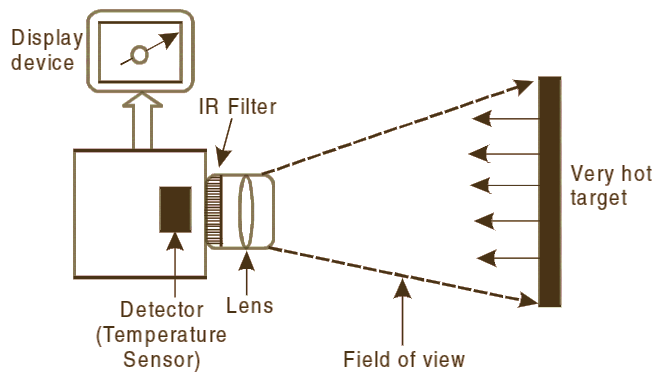
Figure 1: Infrared Pyrometer.
Every material with temperature above absolute zero emits infrared radiations proportional to the temperature. Infrared radiations are invisible to the human eye and can be sensed as heat. An infrared pyrometer is a non-contact-type sensor used to detect infrared radiation from a hot body. The radiation emitted by hot body has different wavelengths. Radiations having longer wavelengths than visible light are known as infrared radiations which possess less energy and are less harmful. A part of the infrared energy radiated by target is detected by an infrared detector to measure. The surface of the target begins to radiate when it attains a temperature of around 500 – 600°C. The infrared energy increases with increase in temperature.
Working Principle of Infrared Pyrometer
The benefit of infrared sensor is formed in Wien’s displacement I law which states that the maximum radiant intensity of low temperature bodies occurs in the infrared for example, at 25°C (298K) the body radiates at the maximum wavelength of 9.7 µm as per Wien’s law.
λmax is the wavelength at which the maximum value of monochromatic emissive power occurs. Wien’s law states that the product of λmax and T is constant i.e.
λmax T = 2.898 x 10-3
Thus,
λmax for 298 K = 9.7 x 10-6 m
Maximum wavelength = 9.7 µm (λmax for 298 K )
Normally radiations with the wavelength range of 0.7 – 14 µm are employed for measurement.
Construction & Working of Infrared Pyrometer
An infrared pyrometer consists of which four the infrared wave detector (temperature sensor). The infrared radiation is absorbed and converted into an electrical signal by the temperature detector. The amount of radiation striking the detector influences the electrical output signal. The amplified electrical output signal is then displayed on the display device with temperature units. Variation due to ambient temperature is properly compensated before display.
Advantages of Infrared Pyrometer
The infrared pyrometer provides better accuracy if emissivity of the material is known. Higher the emissivity of the material higher the accuracy of measurement.
Applications of Infrared Pyrometer
An infrared pyrometer is also useful for the measurement of temperatures of moving objects and in situations where objects are placed in vacuum or in a controlled atmosphere, or the distance between the source of the temperature and the instrument of measurement is large and when the objects are in inaccessible areas and hazardous conditions.